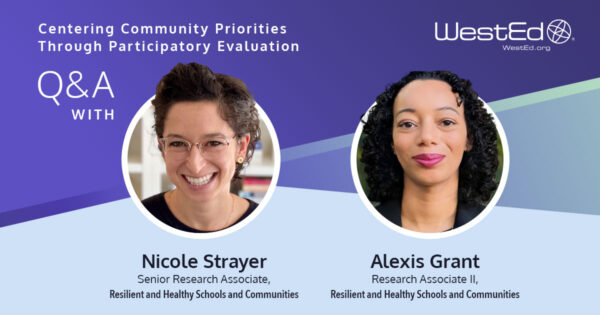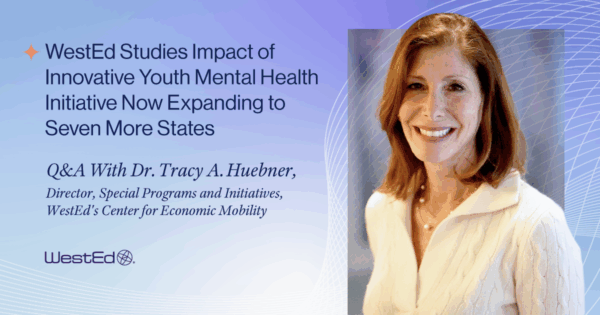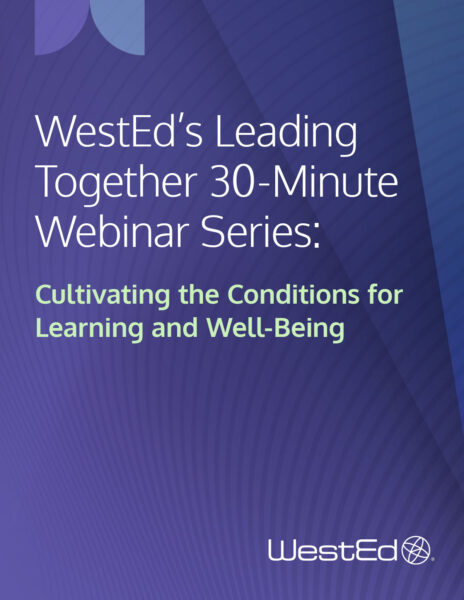
October 22, 2025
Amid today’s complex challenges—from the impacts of the pandemic to shifting social, economic, and global circumstances—educational institutions require innovative ways to create safer, more supportive, and resilient learning communities.
This Spotlight highlights seven approaches that some schools and districts are taking to promote student health and well-being.
Forging Partnerships for Lasting Mental Health Supports
Paradise Unified School District in California recently launched several initiatives aimed at creating supportive school climates, expanding students’ access to mental health services, and developing partnerships to enhance overall student well-being. The district succeeded in reducing students’ feelings of chronic sadness and hopelessness and in lowering suicide rates.
The district’s collaboration with Project Cal-Well, a program implemented by the California Department of Education in partnership with local education agencies throughout California, is a key component of the district’s success.
Applying Evidence-Based Solutions to Keep Schools Safe
In a recent blog post, Ashley Boal of WestEd’s Justice & Prevention Research Center discusses how schools are seeking solutions to keep students and staff safe—and how WestEd is contributing to these efforts through research and evaluation.
Boal explores solutions such as
- state school safety centers,
- school police reform,
- behavioral threat assessment,
- training for police in schools, and
- school-based firearms.
For example, findings from our evaluation of state school safety centers supported policymakers and agency leaders in developing effective systems to support school safety, including a framework to guide the development and refinement of school safety centers.
Creating Districtwide Policies for Student Health and Nutrition
Wellness policies that support collaboration, implementation, and evaluation lay the foundation for healthy school environments. The Los Angeles Unified Board of Education’s Blueprint for Wellness Policy guides the district’s implementation of a comprehensive health and wellness plan for students, families, and staff.
Listen to this audiocast to learn more about the blueprint.
Addressing Trauma With Trauma-Informed Practices
Trauma-informed practices aim to understand how traumatic experiences shape thoughts and behaviors and to build supportive relationships that help students overcome their negative impacts. In this blog post, experts Natalie Walrond, Robin Ahigian, Rebeca Cerna, and Jenny Betz discuss the key roles district leaders play in implementing and sustaining trauma-healing systems in schools.
They note that leaders interested in strengthening trauma-informed practices can start by providing professional learning opportunities to help all staff “understand what trauma is, how to notice and respond to it, and how it negatively impacts student success as well as the school and community culture and climate.”
Collaborating to Tackle Chronic Absenteeism Early
In this interview, Cecelia Leong of Attendance Works talks about the importance of collaboration as a strategy for addressing chronic absenteeism.
“One of the most effective approaches is breaking down silos and fostering collaboration across departments—such as integrating attendance, academics, and behavior supports—to address the whole child. Conducting relational home visits, engaging in respectful communication, and creating a sense of belonging have proven especially impactful in sustaining strong family engagement and student connectedness.
County offices of education and community groups can make a difference by helping coordinate services, improving access to mental health support, and reducing administrative burdens on districts.”
Engaging Families as Essential Partners
In a recent webinar, family engagement expert and Senior Engagement Manager at WestEd Maria Paredes discusses how to create welcoming school environments, maintain clear and open communication, and actively engage with families. Paredes explores the following topics:
- creating a welcoming physical environment
- optimizing personal interactions
- providing families with opportunities for learning and leadership
Prioritizing Educator Well-Being
Creating a Culture of Care, written by Christina Pate, Theresa Pfister, and Tye Ripma, is for education leaders at all levels—local, regional, and state—in charge of supporting their education staff. The guide offers practical information and guidance on educator well-being in these challenging times. It includes the following sections to help education leaders cocreate educational environments that are systems of well-being:
- Key Concepts: the “what” and “why,” providing background information on the ecological systems framework and the root causes of and conditions for well-being; the relationship between brains, bodies, behaviors, and environments; influences of bias and perception on educator well-being; and shifting systems
- Tips for Using the Strategies: the foundational elements of applying the guide’s strategies
- Strategies: the “how,” offering some ways to rethink and redesign education systems as well as some preventative and restorative strategies, with specific examples
- References: works cited throughout the guide
Read Creating a Culture of Care.
How We Help
WestEd partners with leaders to create responsive, safe, and supportive learning environments that foster a strong school climate and lasting conditions for students, educators, and communities to thrive.









